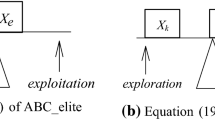Abstract
Extreme learning machine (ELM) as a new learning approach has shown its good generalization performance in regression and classification applications. Clustering analysis is an important tool to explore the structure of data and has been employed in many disciplines and applications. In this paper, we present a method that builds on ELM projection of input data into a high-dimensional feature space and followed by unsupervised clustering using artificial bee colony (ABC) algorithm. While ELM projection facilitates separability of clusters, a metaheuristic technique such as ABC algorithm overcomes problems of dependence on initialization of cluster centers and convergence to local minima suffered by conventional algorithms such as K-means. The proposed ELM-ABC algorithm is tested on 12 benchmark data sets. The experimental results show that the ELM-ABC algorithm can effectively improve the quality of clustering.
















Similar content being viewed by others
References
Alshamiri AK, Singh A, Surampudi BR (2014) A novel elm k-means algorithm for clustering. In: Proceedings of 5th joint international conference on swarm, evolutionary and memetic computing (SEMCCO 2014) and fuzzy and neural computing (FANCCO 2014), Odisha, India (To appear)
Camastra F, Verri A (2005) A novel kernel method for clustering. IEEE Trans Pattern Anal Mach Intell 27(5):801–805
Chaurasia SN, Singh A (2015) A hybrid swarm intelligence approach to the registration area planning problem. Inform Sci 302:50–69
Chitta R, Jin R, Havens TC, Jain AK (2011) Approximate kernel k-means: solution to large scale kernel clustering. In: Proceedings of 17th ACM SIGKDD international conference on knowledge discovery and data mining (KDD), New York, USA, pp 895–903
Falkenauer E (1998) Genetic algorithm and grouping problems. Wiley, New York
Filippone M, Camastra F, Masulli F, Rovetta S (2008) A survey of kernel and spectral methods for clustering. Pattern Recognit 41:176–190
Fisher RA (1936) The use of multiple measurements in taxonomic problems. Ann Eugen 7:179–188
Girolami M (2002) Mercer kernel based clustering in feature space. IEEE Trans Neural Netw 13(3):780–784
Han J, Kamber M (2001) Data mining: concepts and techniques. Academic Press, San Diego
He Q, Jin X, Du C, Zhuang F, Shi Z (2014) Clustering in extreme learning machine feature space. Neurocomputing 128:88–95
Huang G-B (2003) Learning capability and storage capacity of two-hidden-layer feedforward networks. IEEE Trans Neural Netw 14(2):274–281
Huang G-B, Zhu Q-Y, Siew C-K (2004) Extreme learning machine: a new learning scheme of feedforward neural networks. In: Proceedings of international joint conference on neural networks (IJCNN), vol 2. Budapest, Hungary, pp 985–990
Huang G-B, Chen L, Siew C-K (2006a) Universal approximation using incremental constructive feedforward networks with random hidden nodes. IEEE Trans Neural Netw 17(4):879–892
Huang G-B, Zhu Q-Y, Siew C-K (2006b) Extreme learning machine: theory and applications. Neurocomputing 70:489–501
Huang G-B, Zhou H, Ding X, Zhang R (2012) Extreme learning machine for regression and multiclass classification. IEEE Trans Syst Man Cybern B Cybern 42(2):513–529
Jain AK (2010) Data clustering: 50 years beyond k-means. Pattern Recognit 31:651–666
Jain AK, Dubes RC (1989) Algorithms for clustering data. Prentice-Hall, Englewood Cliffs
Jain AK, Murty MN, Flynn PJ (1999) Data clustering: a review. ACM Comput Surv 31(3):264–323
Karaboga D (2005) An idea based on honey bee swarm for numerical optimization. In: Technical report-TR06. Erciyes University, Engineering Faculty, Computer Engineering Department, Turkey
Karaboga D, Basturk B (2007) A powerful and efficient algorithm for numerical function optimization: artificial bee colony (abc) algorithm. J Glob Optim 39(3):459–471
Karaboga D, Ozturk C (2010) A novel clustering approach: artificial bee colony (abc) algorithm. Appl Soft Comput 11:652–657
Krishna K, Murty MN (1999) Genetic k-means algorithm. IEEE Trans Syst Man Cybern B Cybern 29(3):433–439
Lan Y, Soh YC, Huang G-B (2010) Constructive hidden nodes selection of extreme learning machine for regression. Neurocomputing 73:3191–3199
Ng MK (2000) A note on constrained k-means algorithms. Pattern Recogn 33:515–519
Scholkopf B, Smola A, Muller K (1998) Nonlinear component analysis as a kernel eigenvalue problem. Neural Comput 10(5):1299–1319
Selim SZ, Al-sultan K (1991) A simulated annealing algorithm for the clustering problems. Pattern Recogn 24(10):1003–1008
Serre D (2002) Matrices: theory and applications. Springer, NewYork
Shelokar P, Jayaraman V, Kulkarni B (2004) An ant colony approach for clustering. Analytica Chimica Acta 509:187–195
Sundar S, Singh A (2010) A swarm intelligence approach to the quadratic multiple knapsack problem. In: Proceedings of the 17th international conference on neural information processing (ICONIP 2010). Lecture notes in computer science, vol 6443, pp 626–633
Sundar S, Singh A (2014) Metaheuristic approaches for the blockmodel problem. IEEE Syst J. doi: 10.1109/JSYST.2014.2342931
Tzortzis GF, Likas AC (2009) The global kernel k-means algorithm for clustering in feature space. IEEE Trans Neural Netw 20(7):1181–1194
van der Merwe D, Engelhrecht A (2003) Data clustering using particle swarm optimization. In: Proceedings of IEEE congress on evolutionary computation (CEC 03). Canbella, Australia, pp 215–220
Venkatesh P, Singh A (2015) Two metaheuristic approaches for the multiple traveling salesperson problem. Appl Soft Comput 26:74–89
Xu R, Wunsch II D (2005) Survey of clustering algorithms. IEEE Trans Neural Netw 16(3):645–678
Yan X, Zhu Y, Zou W, Wang L (2012) A new approach for data clustering using hybrid artificial bee colony algorithm. Neurocomputing 97:241–250
Zhang L, Cao Q (2011) A novel ant-based clustering algorithm using the kernel method. Inform Sci 181:4658–4672
Zhang R, Rudnicky AI (2002) A large scale clustering scheme for kernel k-means. In: Proceedings of 16th international conference on pattern recognition (ICPR), vol 4, Quebec, Canada, pp 289–292
Zhang C, Ouyang D, Ning J (2010) An artificial bee colony approach for clustering. Expert Syst Appl 37:4761–4767
Author information
Authors and Affiliations
Corresponding author
Additional information
Communicated by V. Loia.
Rights and permissions
About this article
Cite this article
Alshamiri, A.K., Singh, A. & Surampudi, B.R. Artificial bee colony algorithm for clustering: an extreme learning approach. Soft Comput 20, 3163–3176 (2016). https://doi.org/10.1007/s00500-015-1686-5
Published:
Issue Date:
DOI: https://doi.org/10.1007/s00500-015-1686-5




